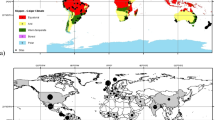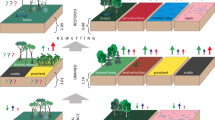Abstract
Land-use change alters catchment hydrology by influencing the quality and quantity of partitioned rainfall. We compared rainfall partitioning (throughfall, stemflow and interception) and nutrient concentrations in rainfall, throughfall and stemflow in three land-use types [primary forest (PF), secondary forest (SF) and agriculture (A)] in Panama. Measurements of throughfall were highly variable which may have masked seasonal and land use differences but it was clear that throughfall at agricultural sites made up a larger proportion of gross precipitation than at forest sites. Of incident precipitation, 94% became throughfall in agriculture sites while 83 and 81% of gross precipitation became throughfall in PF and SF, respectively. The size of the precipitation event was the main driver of variation in throughfall and stemflow. Consistent patterns in nutrient cycling were also difficult to identify. Vegetation has a vital role in delivering nutrients as throughfall deposition of K was often larger than precipitation deposition. A canopy budget model indicated that canopy exchange was often more dominant than dry deposition. Throughfall was generally enriched with nutrients, especially K and Mg, with enrichment factors of up to 17 and 5 for K and Mg, respectively, in PF. In contrast, Ca was sometimes taken up by the canopy. Values of nutrient deposition were high (with up to 15, 3, 30 and 15 kg ha−1 month−1 in stand deposition of Ca, Mg, K and Na, respectively in PF), possibly due to the slash-and-burn agricultural practices in the area or marine inputs. Throughfall and stemflow are vital sources of nutrients in these ecosystems.




Similar content being viewed by others
References
ANAM (2000) Mapa de vegetación de Panamá. Informe final. Autoridad Nacional del Ambiente, Panama City
Brauman KA, Freyberg DL, Daily GC (2010) Forest structure influences on rainfall partitioning and cloud interception: a comparison of native forest sites in Kona, Hawai’i. Agric For Meteorol 150:265–275
Bredemeier M (1988) Forest canopy transformation of atmospheric deposition. Water Air Soil Pollut 40:121–138
Carlyle-Moses DE, Flores Laureano JS, Price AG (2004) Throughfall and throughfall spatial variability in Madrean oak forest communities of northeastern Mexico. J Hydrol 297:124–135
Carlyle-Moses DE, Park AD, Cameron JL (2010) Modelling rainfall interception loss in forest restoration trials in Panama. Ecohydrology 3:272–283
Carrasquilla LGR (2006) Arboles y arbustos de Panama: Trees and shrubs of Panama, 1st edn. Editora Novo Art, National Environmental Authority, University of Panama, Panama City
Cattan P, Bussière F, Nouvellon A (2007) Evidence of large rainfall partitioning patterns by banana and impact on surface runoff generation. Hydrol Process 21:2196–2205
Cavelier J, Jaramillo M, Solis D, de León D (1997) Water balance and nutrient inputs in bulk precipitation in tropical montane cloud forest in Panama. J Hydrol 193:83–96
Crockford RH, Richardson DP (2000) Partitioning of rainfall into throughfall, stemflow and interception: effect of forest type, ground cover and climate. Hydrol Process 14:2903–2920
Demarez V, Duthoit D, Baret F, Weiss M, Dedieu G (2008) Estimation of leaf area and clumping indexes of crops with hemispherical photographs. Agric For Meteorol 148:644–655
Dezzeo N, Chacón N (2006) Nutrient fluxes in incident rainfall, throughfall, and stemflow in adjacent primary and secondary forests of the Gran Sabana, Southern Venezuela. For Ecol Manag 234:218–226
Dietz J (2007) Rainfall partitioning in differently used montane rainforests of Central Sulawesi, Indonesia. Doctoral dissertation, University of Göttingen. http://webdoc.sub.gwdg.de/diss/2007/dietz/
ETESA (2008) Total mensual de precipitation. Santa Fe. Gerencia de hidrometerologica y Estudios. Empresa de transmision electrica S.A, Panama City
Fleischbein K, Wilcke W, Goller R, Boy J, Valarenzo C, Zech W, Knoblich K (2005) Rainfall interception in a lower montane forest in Ecuador: effects of canopy properties. Hydrol Process 19:1355–1371
Flores de Gracia EE (2005) Farm or forest: conservation of the Panamanian watershed, the Bulaba sub-basin study. ETFRN News 45(46):60–62
Herwitz SR (1985) Interception storage capacities of tropical rainforest canopy trees. J Hydrol 77:237–252
Herwitz SR (1986) Episodic stemflow inputs of magnesium and potassium to a tropical forest floor during heavy rainfall events. Oecologia 70:423–425
Hodnett M, da Silva LP, da Rocha H, Cruz Senna R (1995) Seasonal soil water storage changes beneath central Amazonian rainforest and pasture. J Hydrol 170:233–254
Hölscher D, Köhler L, Leuschner C, Kappelle M (2003) Nutrient fluxes in stemflow and throughfall in three successional stages of an upper montane rain forest in Costa Rica. J Trop Ecol 19:557–564
Huber A, Iroumé A (2001) Variability of annual rainfall partitioning for different sites and forest covers in Chile. J Hydrol 248:78–92
Keim RF, Skaugset AE, Weiler M (2005) Temporal persistence of spatial patterns in throughfall. J Hydrol 314:263–274
Krämer I, Hölscher D (2009) Rainfall partitioning along a tree diversity gradient in a deciduous old-growth forest in Central Germany. Ecohydrology 2:102–114
Levia DF, Frost EE (2003) A review and evaluation of stemflow literature in the hydrologic and biogeochemical cycles of forested and agricultural ecosystems. J Hydrol 274:1–29
Levia DF, Frost EE (2006) Variability of throughfall volume and solute inputs in wooded ecosystems. Prog Phys Geogr 30:605–632
Levia DF, Keim RF, Carlyle-Moses DE, Frost EE (2011) Throughfall and stemflow in wooded ecosystems. In: Levia DF, Carlyle-Moses D, Tanaka T (eds) Forest hydrology and biogeochemistry: synthesis of past research and future directions. Springer, Dordrecht, pp 425–443
Lilienfein J, Wilcke W (2001) Nutrient input from the atmosphere into Brazilian savanna oxisols under corn. Soil Sci 166:391–399
Lilienfein J, Wilcke W (2004) Water and element input into native, agri- and silvicultural ecosystems on the Brazilian savanna. Biogeochemistry 67:183–212
Lloyd CR, Gash JHC, Shuttleworth WJ, Marques F (1988) The measurement and modelling of rainfall interception by Amazonian rainforest. Agric For Meteorol 43:277–294
Loescher HW, Powers JS, Oberbauer SF (2002) Spatial variation of throughfall volume in an old-growth tropical wet forest, Costa Rica. J Trop Ecol 18:397–407
Lovett GM, Nolan SS, Driscoll CT, Fahey TJ (1996) Factors regulating throughfall flux in a New Hampshire forested landscape. Can J For Res 26:2134–2144
Lovett GM, Bowser JJ, Edgerton ES (1997) Atmospheric deposition to watersheds in complex terrain. Hydrol Process 11:645–654
Mair A, Fares A (2010) Throughfall characteristics in three non-native Hawaiian forest stands. Agric For Meteorol 150:1453–1466
McJannet D, Wallace J, Reddell P (2007) Precipitation interception in Australian tropical rainforests: I. Measurements of stemflow, throughfall and cloud interception. Hydrol Process 21:1692–1702
Parker GG (1983) Throughfall and stemflow in the forest nutrient cycle. Adv Ecol Res 13:99–114
Ponette-González AG, Weathers KC, Curran LM (2010a) Tropical land-cover change alters biogeochemical inputs to ecosystems in a Mexican montane landscape. Ecol Appl 20:1820–1837
Ponette-González AG, Weathers KC, Curran LM (2010b) Water inputs across a tropical montane landscape in Veracruz, Mexico: synergistic effects of land cover, rain and fog seasonality, and interannual precipitation variability. Glob Change Biol 16:946–963
Robson AJ, Neal C, Ryland GP, Harrow M (1994) Spatial variations in throughfall chemistry at small plot scale. J Hydrol 158:107–122
Scheer MB (2011) Mineral nutrient fluxes in rainfall and throughfall in a lowland Atlantic rainforest in southern Brazil. J For Res 16:76–81
Staelens J, Houle D, De Schrijver A, Neirynck J, Verheyen K (2008) Calculating dry deposition and canopy exchange with the canopy budget model: review of assumptions and application to two deciduous forests. Water Air Soil Pollut 191:149–169
Suman D (1989) Dry deposition removal of carbonaceous particles produced by biomass burning in Panama. Aerosol Sci Technol 10:131–139
Talkner U, Krämer I, Hölscher D, Beese FO (2010) Deposition and canopy exchange processes in central-German beech forests differing in tree species diversity. Plant Soil 336:405–420
Ulrich B (1983) Interaction of forest canopies with atmospheric constituents: SO2, alkali and earth alkali cations and chloride. In: Ulrich B, Pankrath J (eds) Effects of accumulation of air pollutants in forest ecosystems. D Reidel, Dordrecht, pp 33–45
Weiss M, Baret F, Smith GJ, Jonckheere I (2004) Methods for in situ leaf area index measurement, part II: from gap fraction to leaf area index: retrieval methods and sampling strategies. Agric For Meteorol 121:17–53
Wilcke W, Günter S, Alt F, Geißler C, Boy J, Knuth J, Oelmann Y, Weber M, Valarezo C, Mosandl R (2009) Response of water and nutrient fluxes to improvement fellings in a tropical montane forest in Ecuador. For Ecol Manag 257:1292–1304
Wullaert H, Pohlert T, Boy J, Valarezo C, Wilcke W (2009) Spatial throughfall heterogeneity in a montane rain forest in Ecuador: extent, temporal stability and drivers. J Hydrol 377:71–79
Zimmermann A, Wilke W, Elsenbeer H (2007) Spatial and temporal patterns of throughfall quality and quantity in a tropical montane forest in Ecuador. J Hydrol 343:80–96
Zimmermann A, Germer S, Neill C, Krusche AV, Elsenbeer H (2008) Spatio-temporal patterns of throughfall and solute deposition in an open tropical rain forest. J Hydrol 360:87–102
Zimmermann A, Zimmermann B, Elsenbeer H (2009) Rainfall redistribution in a tropical forest: Spatial and temporal patterns. Water Resour Res 45:W11413
Acknowledgments
We thank the landowners for allowing access to sites. We acknowledge the contribution of CATHALAC (Water Center for the Humid Tropics of Latin America and The Caribbean) and our field and laboratory technicians. We would also like to thank the reviewers for their valuable comments on an earlier version of the manuscript. LS was an employee of the University of Göttingen while conducting this research and acknowledges the support provided by Dirk Hölscher and his research group. This research project was funded through the grant COL07-44 from SENACYT (Secretaría Nacional de Ciencia, Tecnología e Innovación) in Panama. Funds from The University of Auckland School of Environment PBRF fund assisted in the completion of this manuscript.
Author information
Authors and Affiliations
Corresponding author
Rights and permissions
About this article
Cite this article
Macinnis-Ng, C.M.O., Flores, E.E., Müller, H. et al. Rainfall partitioning into throughfall and stemflow and associated nutrient fluxes: land use impacts in a lower montane tropical region of Panama. Biogeochemistry 111, 661–676 (2012). https://doi.org/10.1007/s10533-012-9709-0
Received:
Accepted:
Published:
Issue Date:
DOI: https://doi.org/10.1007/s10533-012-9709-0




